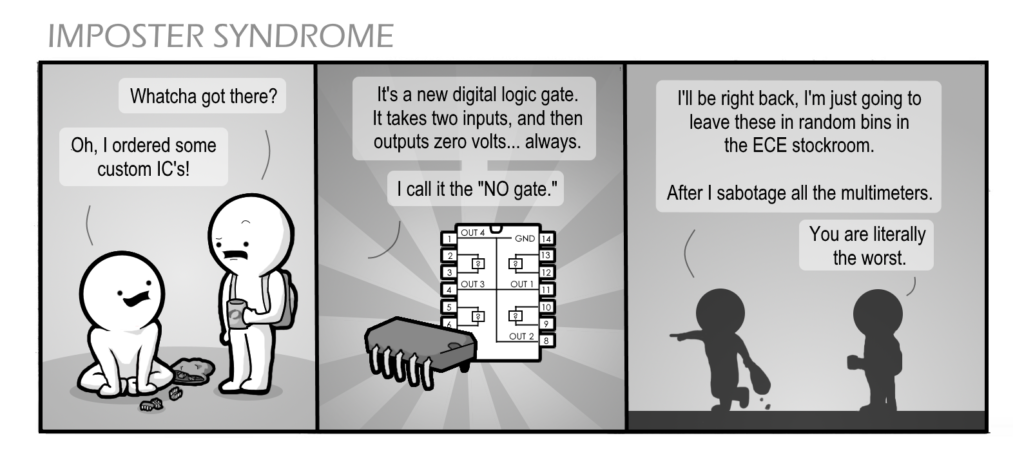In my past visit to the doctor, I asked for advice on what birth control method to use. My doctor suggested all hormonal based birth control and didn’t even mention the basal temperature and fertility awareness based methods that I looked into. When I asked her about it she said it was almost unusable and brushed it off completely.
This response stalled me for six months in deciding what to do next, what to research and how to make a decision that was best for me. I became incredibly skeptical of this doctor’s advice, but even then I could not understand. Did she receive negative feedback from others using this method? Does she not like the basal temperature method because it’s based on an algorithm instead of hormones? Was she unwilling to accept that I could look to solutions outside of that doctor’s office that are just as medically backed? And a last option, what if she actually had the best intentions and was just trying to help?
I found that fertility awareness based methods work by tracking your cycle through basal temperature patterns corresponding to hormone changes, cervical fluid, your period, and hormone tests (like an LH, luteinizing hormone test). There are about six days per month that a person who menstruates shouldn’t have unprotected sex (if using this method as birth control), based on the survival of sperm and the day you ovulate.
The method that I found works with an app called NaturalCycles, which works 93% of the time with typical use and 99% with perfect use (as compared to the pill, which is 91% effective with typical use and 99% with perfect use). The app is a certified medical device under an international ISO standard. As a brief explanation, this app is based on an algorithm that tracks information about your basal temperature, your period and LH tests. With this information, it can pinpoint the day you ovulate and basically tell you when to avoid unprotected sex. I have also talked to someone who tracks their cervical fluid and position as another way of understanding their cycle. I would suggest looking into all of this and any other method you are thinking about pursuing.
Hormonal birth control has been the default since the pill was popularized and to me, the fact that this is a default can be oppressive considering new technologies. Instead of trying to understand how a menstrual cycle works, the first solution is to alter hormones to stop the cycle altogether, and therefore increasing the possibility of depression. While I understand hormonal birth control has medical uses and benefits, I think some people might be more empowered through a furthered understanding of their hormonal cycle to prevent pregnancy. And I don’t think young people should immediately be given the advice to use hormonal options, without knowing the ways it can affect their life and well-being.
I’m not trying to tell people not to use hormonal birth control and I know those methods work really well for people who choose to use them. But I do want to remind everyone to be just a bit skeptical of people in positions of power, especially when it’s about your health and personal choices in systems that have long been used to oppress women and minorities in society.
I thought my experiences were important to share because I think birth control isn’t widely talked about, but it can drastically impact a person’s life. I want everyone to be able to make their own educated choices that are best for them.
If anyone wants to talk to me about my choices or this article, feel free to email me at emily.kohler@students.olin.edu or just come and talk to me sometime.
Citation
https://www.naturalcycles.com/en/science
https://www.plannedparenthood.org/learn/birth-control/birth-control-pill/how-effective-is-the-birth-control-pill
A Sappy Gay Romance
The screams and hollers echoed across the beach. Kids were home for the summer. It was a small town, but it came alive every June.
Some kids would not return. They had jobs or relationships to keep. But I returned. I always did. And I hoped this would be the year that he stopped.
Suddenly, the calls became more distinct, as the man that I loved stepped on the dance floor. The girls latched onto him, and I sat patiently at the bar as he danced with each and every one.
“Isn’t he getting a bit too loose?”
“No. He does this every year. He’s just humoring them.”
“You are absolutely crazy. What do you suppose he gets up to at that college of his?”
“I don’t know, nor do I want to.”
He finally swaggered over, and suddenly we were alone. There was nothing that could ruin this night. As we hit 2 AM, slower songs were played. Swaying together under the strung up lanterns, I forgot how awkward it had been the first time, the both of us having to learn how men danced together.
“Hey.”
I pulled back a bit to look him in the eyes.
“What’s up?”
He smiled. “What d’you say we get out of here, for a bit?”
We snuck out of the festivities, heading farther down the beach. I dragged him into the water, both of us hating how stupidly cold it felt on first impact.
“You gonna stick around for the summer?”
He didn’t answer, just started arcing his foot through the water and flicking droplets into the air. I knew better than to wait for a real answer. Even the times when he was technically in town, we really only saw each other a handful of times. So instead of brooding over what wouldn’t happen, I poked his shoulder.
“Tag.”
I ran, harder than I ever had before in my life. But it didn’t matter. He was faster than me. He tackled me, and we both fell hard to the ground, laughing our heads off.
What I hadn’t anticipated was pulled into the path of the waves, screaming in indignation when the cold water crashed over me.
“So what’re we gonna get up to tonight, other than you getting soaked?”
I threw wet sand at him, which resulted in both of us getting wetter and sandier than was strictly speaking comfortable.
“Oh, to hell with it.” I yanked off my jeans, pretense be damned. Instantly felt ten degrees warmer. Then I laughed at the look of audacity on his face.
“Uh, we’re in public?”
“And these boxers are longer than shorts that girls wear in public. And it’s night. And you can loosen up a little.”
After squirming a little, he followed my lead. We each had jackets that had been left with shoes and phones at the top of the beach. Music came on from some crappy built-in speakers.
We danced till dawn, singing all the songs we knew by heart and even the ones we didn’t.
And just like that, the night was over. The summer would follow.
Grab a Fika!
Where is sporting costumes, singing songs and receiving a warm welcome to your new school a regular thing? Well, grab a fika, and we’ll tell you. If you were in the UK, it might be teatime but if you are lucky enough to be in Sweden, it’s a cozy coffee break or fika. Fika is an important aspect of Swedish culture and this is evident everywhere: at home, in the workplace, and on college campuses.
At LTH, the Engineering Faculty at Lund University, companies sponsor student events in order to get their names out among this cohort of future employee candidates. One of those events is the annual Nollning – the word in Swedish refers to an introduction for new and first-year students – a tradition at the prestigious Lund University in Lund, Sweden. Upperclassmen plan a variety of activities to give new students the opportunity to meet new friends, feel wel-
comed to their new home and to feel lagom, or in English, just right! The introduction lasts for five weeks and includes roughly 1200 new students with about 500 student mentors making it happen.
During Nollning, LTH students dress up in the different colors that represent their discipline, for example, mechanical engineers are red, computer science students are pink and electrical engineers are white. The disciplines compete against each other in different missions to celebrate fraternity and passion for their field. Nollning is a tradition that
connects students’ social and educational lives and is highly valued by Swedes.
If Olin College wants to prepare students to become innovative engineers who engage in creative solutions for the good of the world, then Oliners should get to know the world and the people in it. Learning about other cultures is filled with eye-opening and transformative experiences which is why I have embraced learning in a new environment. While I miss my home institution and my friends, studying in the United States has enriched my academic experience and provided meaningful cultural engagement with people from many backgrounds. I would encourage anyone who has the opportunity to study abroad!
Now you know 3 words in Swedish and a little about Swedish culture. If you would like to learn more, I am happy to share!
-Viktoria


In Defense of “A Defense”
 Last month, in Mitch Cieminski’s article, “The Mercator Needs no Defense”, he made several compelling arguments advocating for the globe in favor of maps, and the Mercator Projection in particular. While the globe has its distinct advantages, so too do maps. We could argue for days about when maps are better than globes and which projection is best (the answer is Lee), but I fear Mr. Cieminski as well as many other readers may have taken my argument too far. To be clear, my article was merely a thought experiment, not to be taken seriously. After all, the entire notion of a map projection is nonsensical. To “project” the Earth onto a plane implies the Earth is not a plane to begin with. Round Earth Theory is an unfortunately widespread misconception that seems to have, in spite of obvious evidence all around us and empirical measurements of the Earth’s lack of curvature, made its way into Olin. I assumed while writing my little thought experiment that all readers would be aware of the true nature of the Earth, but I see now that I will need to educate the Olin community.
Last month, in Mitch Cieminski’s article, “The Mercator Needs no Defense”, he made several compelling arguments advocating for the globe in favor of maps, and the Mercator Projection in particular. While the globe has its distinct advantages, so too do maps. We could argue for days about when maps are better than globes and which projection is best (the answer is Lee), but I fear Mr. Cieminski as well as many other readers may have taken my argument too far. To be clear, my article was merely a thought experiment, not to be taken seriously. After all, the entire notion of a map projection is nonsensical. To “project” the Earth onto a plane implies the Earth is not a plane to begin with. Round Earth Theory is an unfortunately widespread misconception that seems to have, in spite of obvious evidence all around us and empirical measurements of the Earth’s lack of curvature, made its way into Olin. I assumed while writing my little thought experiment that all readers would be aware of the true nature of the Earth, but I see now that I will need to educate the Olin community.
When first confronted with the planar Earth model, it is easy for one to brush it off as conspiracy theory nonsense. This is an acceptable response. In your defense, the government has been feeding you lies all your life in an attempt to make you easier to control. Therefore, I ask that you open your mind and temporarily cast aside all of the “facts” that you think you know, and instead of blindly relying on science for all the answers, actually think critically about the world and compose your model of the universe out of empirical evidence. Chances are, your teachers in elementary school were all under the same illusion as you are, so nothing they told you can be taken for granted. Photographs are easily falsified, so pictures of spherical earths and ship masts are not acceptable evidence, either. The only way to truly learn about the world is to trust your own twenty-one senses.
Now that that is out of the way, let me tell you what the Earth really looks like. The world is a large disc about 40,000 kilometers across with the North Pole in the center and the ice wall known as Antarctica surrounding it on all sides. The true map corresponds to what round-earthers call the “Polar projection” and can be found on the flag of the UN. What lies beyond the coast of Antarctica is a matter of great interest to those who know the truth. The sun and moon are both 50 km across and 5,000 km above the Earth’s surface. The sun circles the North Pole, sweeping its spotlight-like light across the time-zones. The moon follows a similar path, though at a slightly lower altitude, allowing for solar eclipses. A similarly sized third celestial body known as “the dark object” also orbits at a lower altitude, but is only visible when it moves in front of the moon during lunar eclipses (if that sounds ridiculous to you, remember that according to NASA, most of the mass in the galaxy is invisible). The entire system accelerates upward at 9.8 meters per second squared, creating the phenomenon most people know as “gravity”.
A common misconception regarding the spotlight sun model is that in order for the sun to set, it must sink beneath the Earth, which would plunge the entire world into darkness simultaneously. This is obviously not the case, as can be proven by anyone who has ever Skyped with someone in a different time zone. In actuality, the sunset is an illusion. As the sun moves horizontally farther away from an observer, it appears to move closer to the horizon because of perspective. It also appears to stay the same size, though, because of the way bright lights refract through large quantities of air. This phenomenon is why you can see the streetlights on the other side of a city even though when turned off they are far too distant to see. When the edge of the sun’s spotlight approaches the observer, the sun is so far away that it appears to be touching the horizon. At this point, high amounts of glare and refraction cause the sun to look far larger and less circular than it should, a fact that even round-earthers will admit (this is related to why one can look directly at a sunset without damaging one’s eyes). Thus, when the sun turns away and finally disappears, it looks as though it has descended beneath the horizon.
At this point, I can practically feel your skepticism. “The Earth can’t be flat,” you think. “For one thing, if the Earth were flat, we wouldn’t have a horizon!” This notion is complete trash. The existence of a horizon does not depend on a round Earth, as anyone who has played a superflat map in Minecraft can tell you. “If the Earth were planar, though,” people say, “you would be able to see from Boston to London. Instead, London is hidden from us by the Earth’s curvature.” This is also completely false. If you have ever stood on the southeastern tip of O’ahu and gazed over the Ka’iwi channel, chances are you will have seen naught but water. If it is a particularly clear day, you may have seen Haleakala on Maui. If it is exceptionally clear and the air highly transparent, you may have even glimpsed the silhouette of Mauna Kea. How far down the archipelago you can see is purely a function of clarity. Distant objects are hidden from us only by the omnipresent haze of slightly opaque air, which is why the clearer the day, the farther you can see. If the Earth truly curved, you would not be able to see Mauna Kea at all, it being a measly 4.2 kilometers above sea level and a whopping 280 kilometers away.
“But why, then, does increasing one’s altitude make more things visible?” you ask. This is common sense. Spherical or planar, the Earth’s surface is not perfectly smooth. In any direction from where you read this, you almost certainly see buildings, hills, mountains, and – if you are somewhere besides Olin – trees. Moving higher up enables an observer to see over these things. On a round Earth, in order to observe the horizon actually moving away, one would have to stand in a high place surrounded by bare flatland with some kind of metric to gauge the “distance” of the horizon (the ocean won’t work because there is no good way to tell how much of it one can see). If such a place existed and were easily accessible, you could test it for yourself and see that as you go higher, you don’t actually see more, but less.
There exist many other common “proofs” that the Earth is round. All are easily explained away by the actual model of the Earth. The fact that vertical sticks cast different shadows on different parts of the Earth is just as justifiable for a globe Earth and a distant sun as it is for a plane Earth and a nearby sun. The fact that other planets are round means little given that the Earth is the center of the Universe and is thus inherently special. The perceived curvature of the Earth one sees when in a plane is an illusion caused by the thick, pressurized airplane window. If that weren’t the case and the Earth’s radius were what the Government tells us it is, planes wouldn’t even fly high enough to see the curvature of the Earth. Similarly, the visual phenomenon of ships appearing mast-first over the horizon is an illusion; any ship at that distance appears small enough that it is easy to trick oneself into seeing what one expects to see. Besides, when was the last time any of you saw a ship with a mast (indefinitely docked historical ships don’t count)?
With all this in mind, the notion that the Earth is not round should be just as plausible as what you were led to believe. Given that, on top of all of this, the Earth _looks_ flat, the burden of proof should really rest on the round-earthers, not us. However, since I know you are all still skeptical, here is some evidence: the Bedford Level Experiment. In 1838, Samuel Birley Rowbotham observed a boat row 10 kilometers down a straight stretch of the Old Bedford River. If the Earth were round, by the time it got 10 kilometers away, the 1-meter mast should have been a full 3 meters below his line of sight. Instead, to his surprise, its height did not appear to change at all as it moved away from him, remaining perfectly visible above the water for the entire 10-kilometer stretch, proving that the Earth is not, in fact, curved, but flat. The masses, of course, paid little heed to the discovery, as confirmation bias will tend to make one do, particularly when the evidence so thoroughly disproves the public’s most basic of understanding of the world. I assume that if you have read this far that you are critical enough to honestly process this information and come to the correct conclusion.
But why would someone do such a thing? If all this is true, then many people must be in on it and have good reason to keep it a secret. To start, whether the space industry is in on it is unknown at this point. In all likelihood, space travel is impossible, so when NASA created the pictures of the Earth for the Apollo program, they depicted it as they expected it to be – round. The fake pictures of a round Earth may simply be the result of the government lying to NASA along with the rest of the citizenry. Why would the Government lie to the citizenry, though? No one is sure, but the best explanation I have found is this: when one thinks they live on a tiny orb orbiting the sun along with seven other planets, hurtling through an unthinkably large galaxy in an unthinkably large universe, it makes one feel insignificant.
And people who feel insignificant are easier to control. Take a look around. The first mentions of a spherical Earth are from the third century. One of the galaxies allegedly in the local group is called “Triangulum”. The first digit of pi is 3. We have three branches of government! Wake up, sheeple. The Illuminati have been lying to you all your life about the nature of the Earth in an attempt to manipulate you. First they tell us the Earth is round. What’s next? Area 51 is a hoax? Lizard people are fake? Olin, it’s time to stand up, look around, and rise against our masters. Judgement day is near. Until then, remember to wear plenty of iron, and never use the same parking stall twice. Stay flat, comrades.
SERV Activity Update
SERV Auction: Justin Kunimune
The SERV Auction has kicked off with the Silent Auction opening this week. Be sure to look through the bids for things that interest you; all money raised will go to the charity chosen by the community. Also be sure to come to the Live Auction on Friday in the Dining Hall during lunch! Proceeds go to Unidos por Puerto Rico.
Big Brothers Big Sisters: Justin Kunimune
The program has started up for the semester, with a total of thirty matches. There have been three outings at Babson thus far, with plenty more scheduled for the rest of the semester.
Charles River Center: Emma Price
The Charles River Center is a non-profit organization based in Needham that works to improve the lives of people with developmental disabilities and help support their families. They have a variety of different programs for people of all ages, all with really fun activities like Zumba and yoga!
MSPCA (Massachusetts Society for the Prevention of Cruelty to Animals): Emma Price
MSCPA is a great organization that takes in animals all over the state, makes sure they’re healthy, and finds good homes for them. They take all variety of animals and have volunteer positions like cat adoption room monitor (that’s what I do), dog walker, small animal monitor, and a ton more!
Bikes Not Bombs: Maggie Jakus
Bikes Not Bombs is an organization that recycles old bicycles and sends bikes to economic development programs around the world as well as youth education programs in the nearby area. They have volunteer nights on Thursdays when volunteers prepare bikes for shipment. You also get to learn a lot about bikes!
Crossword Puzzle

ACROSS
1 Japanese fighting fish
5 Is vaccinated
11 Ortiz and Armas
12 Chinese philosophy
13 Bygone media storer
15 Like outer space
16 Eucalyptus eater
17 Writes down
18 Video game “Orc-Town”
20 Racket overseers
21 Mascot is Pistol Pete
26 More abrupt
28 HP actor ___ Rickman
29 Brains, informally
31 Many messes
33 The world has five of them
36 Artificial caves
38 ___ De Janeiro
39 Zeus and Ares
40 Hospital staffer
41 Dem or Rep
43 Of sturdy wood
47 Francés river
48 Japanese mafia
DOWN
1 Get cold feet (2 words)
2 Sponsor
3 Bubbles voice actress
4 Athens soldier
5 Common sayings
6 Wal ___
7 Chemistry unit
8 Doing 180’s
9 Compass direction
10 Ambulance letters
14 Worlds’ deadliest creature
15 Per ___
19 On the way (informal, 2 words)
22 Greek automaton
23 SNL’s ___ Baldwin
24 Stun-gun
25 printing unit
27 Upheld the law
30 Bone prefix
32 Element #18
34 Casper’s need
35 Italian grandma
37 Give the green light
41 “To ___ or not to ___”
42 Ion battery metal
44 Famed pharaoh
45 Writer ___ Johnston
46 La Jolla college

Imposter Syndrome

Horrorscopes by Spooky Editors
Scorpio (Oct. 23 – Nov. 21): You’ll lose another sock to the dryer and have three lonely socks which is infinitely more awkward than two because two are inevitably better friends than the first and the third one always has to struggle to be included which is just too real a struggle. Lose another sock quick so that little red one doesn’t feel alone anymore.
Sagittarius (Nov. 22 – Dec. 21): You will discover in the spring semester of your senior year that you failed OIE and you will have to take a supersenior semester just to make it up.
Capricorn (Dec. 22 – Jan. 19): You will develop a very convincing maniacal laugh and be cast in the next Tim Burton film. Unfortunately, Johnny Depp will be unfathomably jealous and hold a jar of dirt over you while you sleep.
Aquarius (Jan. 20 – Feb. 18): You’ll adopt another plant and forget to water it just like you forgot to water that basil plant. That helpless basil plant. Only you could take care of it and you couldn’t. You wanted to give it all life had to offer, but you couldn’t even keep it alive. You couldn’t find time to water it. You couldn’t find time in your busy schedule to water the plant that depended on you, and only you, to survive. This is also the month that you will realize that parenthood might not be for you.
Pisces (Feb. 19 – March 20): Good fortune comes to you this month. But beware. Always carry a clove of garlic with you. Not because of vampires but because you never know when it might come in handy.
Aries (March 21 – April 19): You will lose your prox and the dining hall staff will be real sick of your shit by the end of the week.
Taurus (April 20 – May 20): You will realize this month that you don’t want to be an engineer and comparative literature is your passion.
Gemini (May 21 – June 20): You’ve got a jar of diiiiiirt.
Cancer (June 21 – July 22): You’ll have to go over to Babson all by yourself to get coffee. You’ll get asked by three separate people to be their technical co-founders. None of them are thinking of giving you equal share of their company.
Leo (July 23 – Aug. 22): You will hear Thriller and Christmas music in the same day.
Virgo (Aug. 23 – Sept. 22): You will wake up at 11 am on a Saturday only to find that there is no eggs benedict and that Chef Kevin is gone.
Libra (Sept. 23 – Oct. 22): Your advisor will look at your 4-year plan and only be able to say, “Oh, honey.”
A Very Belated Hello
Hi there, Olinauts! You may have noticed that I wasn’t an editor and now I am. I just joined the Frankly Speaking team this year, and I’m finally taking the chance to say hello.
Here’s a little bit about me if you don’t already know who I am: I’m a Robotics major who came to this school with nothing but the ability to program and write any type of bullshit but poetry. I’m easily spotted on most days by a green army shirt and bright red high-tops. My favorite author is Neil Gaiman, and my favorite genre of anything is weird as shit.
I love any music in the realm of classic rock and alternative rock, but I’m going through my angsty music phase now: Fall Out Boy, twenty-one pilots, Panic! at the Disco, you name it. My pride and stubbornness are both my greatest assets and greatest weaknesses. I don’t know when to quit, and nobody tells me what to do but my mother (and sometimes my roommate).
I’m also really excited to work on Frankly Speaking this year.
This newspaper is such a cool way for Olin to speak its mind and offer interesting opinions on things like capitalism and maps.
I’m also hoping to make it a cool way to find out more about what’s going on at Olin from student-run events to faculty research to campus culture discussions and maybe even as a way to find out what’s going on in the world outside of Olin (if that exists).
But sometimes the barrier between “this should be in Frankly Speaking”
to sending it in is actually writing something.
Well, that’s what I’m here for. Do you have something you want to say but don’t know how to say it? Is there something you think someone should write about but don’t have the motivation to write it yourself? Are you slugging through an article but want an outside opinion or maybe just grammar check?
If any of these are you, I’m the person for the job. I’d love to complement the current Frankly Speaking spread with articles grounded in Olin and directly applicable to the Olin community.
If you have ideas for content along these lines, I would love to hear them.
Expect me to bother various club, activity, and student government meetings in the near future.
Is there an event you think I should cover? Let me know. Is there a TV show, movie, or book you want me to review before you commit your own time to it? Let me know.
That being said, I also love the application of critical theory to everyday topics and would love to advise on or write a critical spin on any topic on campus or off. If that’s something you’re into, let me know.
Stay Cool,
Sophia “Will Write for Free” Nielsen
The Mercator Needs No Defense
In last month’s issue of Frankly Speaking, I was disappointed to see a Mercator apologist being given platform to espouse tired rhetoric [1]. Mr. Kunimune’s article, while demonstrably erudite and well-researched, was and is totally unnecessary in a world dominated by the colonialist and abstractionist tyrannies of the Mercator projection.
The distortions inherent in the Mercator projection are by no means insignificant and should be reiterated: Greenland looks the same size as Africa, though Africa is in fact 14 times bigger; Alaska looks the same as Brazil, though Brazil is 5 times bigger, etc. In terms of teaching the size of countries, and, by extension, the relative positions of them, the Mercator is astoundingly bad.
This is not an unimportant issue when it comes to learning geography. The Western geography classroom has for decades been a site of colonialist indoctrination, and the Mercator projection’s continued use in this context serves as an aid to this end. Geography as an academic discipline in the US originated as an imperialist enterprise, and the practice of K-12 geography through the twentieth century emphasized learning about Western nations, colonies, and resources instead of people and places [2]. The use of the Mercator projection draws the eye to the global North: the US, UK, Spain, Germany, etc. while visually de-emphasizing all countries close to the equator (the global South, places historically colonised by the North).
Regardless of if these features of the map are mere “coincidence,” they likely helped it gain traction in geography education. Today, they make that education worse both in fact and in promoted ideology. Though the Mercator may have its redeeming qualities, i.e. for navigation, it should not see use as a general-purpose world map [3]. Surely, we can do better!
There’s one style of world map that can be pretty good, all things considered: a globe. For the unfamiliar, you can find a decent example of one by simply walking uphill from any place at Olin. In lieu of this, I’ve included a pseudo-globe (well, actually, a Dymaxion projection) that you can make yourself [4].
Finally, I’ll leave you with this: maps are mere abstractions (which is not to say that they’re pointless, but that they’re always wrong). As Korzybski once famously said, “The map is not the territory, but, if correct, it has a similar structure to the territory, which accounts for its usefulness” [5]. As Mr. Kunimune pointed out, all map projections are wrong because it is impossible to flatten a sphere. I will here add: all maps are wrong because they are not themselves the world.
[1] Kunimune, J. (2017). Defense of the Mercator. Frankly Speaking 9(1), 6-9. https://franklyspeakingnews.com/2017/09/a-defense-of-the-mercator-projection/
[2] Barnes, T. J. (Eds.). (2000). Inventing Anglo-American economic geography, 1889-1960. In Sheppard E. & Barnes, T. J. (Eds.), A companion to economic geography (pp. 11-26). Oxford: Blackwell Publishers.
[3] Cartographic Notes. (1989). In American Cartographer 16(3), 222–223. http://dx.doi.org/10.
1559/152304089783814089
[4] Gaba, E. (2009). Blank map of the world in an unfolded Fuller projection. Retrieved from Wikimedia Commons https://commons.wikimedia.org/wiki/File%3AFuller_projection_rotated.svg.
[5] Map–territory relation. In Wikipedia, the free encyclopedia. Accessed 2017-09-26. https://en.wikipedia.org/wiki/Map%E2%80%93territory_relation